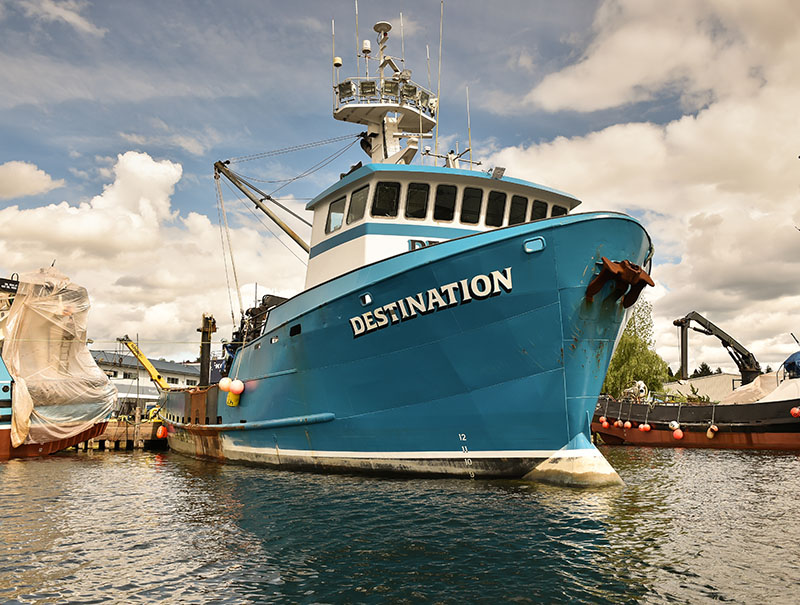We get that can be hard to keep up with all of the news, so here are our editors' picks of the year's top stories. This year's most-read stories include tragedy, a confusing executive order, a huge salmon run, some thoughts on government surveillance and more.
Hearings begin in F/V Destination investigation

The crabber Destination. Photo courtesy Capt. Casey McManus via Facebook.
Hearings into the fatal Feb. 11 sinking of the 98-foot crabber Destination began in early August as Coast Guard officials explore what could’ve caused the accident.
Officials are expected to deliver a report on the incident in February, a full year after the tragedy.
NOAA ships locate wreck of F/V Destination
The wreckage the Destination was found by a NOAA research vessel in July.
The boat was discovered in about 250 feet of water just northwest of St. George Island, Alaska, according to the Coast Guard.
Trump executive order could affect NMFS regulation

President Donald Trump walks into the oval office. Twitter photo by @POTUS.
President Donald Trump’s executive order directing all federal agencies to repeal two existing regulations for each new one is affecting the ability of the National Marine Fisheries Service to regulate the U.S. fishing industry.
“If we now must eliminate two regulations every time a fishery is managed, there will be complete chaos,”Water, Power, and Oceans Subcommittee Ranking Member Jared Huffman said in a press release. “Our fisheries and coastal economies should not have to suffer these consequences.”
Bristol Bay salmon run almost too big to handle
Bristol Bay fishermen and processors are celebrating one of the largest sockeye runs on record. This year’s run was predicted to be 41.5 million fish with a harvest of 27.5 million, but the fleet hauled in more than 37 million fish, and the total run topped 56 million, according to harvest data from the Alaska Department of Fish and Game on Aug. 1.
Losing New Faith: Oregon troller goes down on her maiden tuna voyage

The last photo of the New Faith. USCG photo.
Lorin Dixson, 71, bought the the 40-foot fiberglass troller New Faith in the fall and had been working on her since February to get ready for the tuna season.
At 5 a.m. on Saturday, July 8, New Faith was returning to Charleston, Ore., to offload a haul of albacore tuna. About 60 miles off Coos Bay, Ore., she began going down by the stern.
Fair is fair: Everyone should get a monitor
Effective fisheries management requires cooperation between managers and fishermen. Cooperation involves a certain amount of trust. Managers must be able trust that data being provided by fishermen is correct, and fishermen must trust that managers are analyzing those data properly. It is a two-way street.
So, I am proposing that all NMFS personnel and council members wear a radio collar — similar to what wildlife biologists use on bears, wolves, etc., so we know where they are 24 hours a day, just like a VMS does on a commercial fishing vessel.
Coast Guard suspends search for F/V Destination
Late on Monday Feb. 13, the U.S. Coast Guard suspended its search for the six-man crew of the 98-foot crabber Destination, which sank about two miles northwest of St. George Island, Alaska, just two days earlier.
Will America’s Finest become a failure?

America's Finest under construction. Dakota Creek Industries photo by Mike Nelson.
The most modern and efficient catcher-processor to be built in the Pacific Northwest in 30 years has been grounded by government regulations before she has a chance to slide off the rails.
And just as the future of the boat is at stake, the futures of the builder and buyer — and a bevy of jobs at both companies — are riding on the much-anticipated launch of the 264-foot America’s Finest.
Shark week takes an unexpectedly nasty turn
The Florida Fish & Wildlife Commission is investigating the contents of a video that shows a hooked shark being dragged at high speeds behind an outboard-powered boat.
“This is just really sick, one of the most horrific things I have seen in 50 years of professional sport fishing,” said Florida charter fishing captain Mark “The Shark” Quartiano, who uncovered the video online.
California captain wary of NGO investment
Morro Bay, Calif., captain Rob Seitz, whose boat graced the cover of NF March 2017, wrote a letter "to clear up some glaring half-truths, and no-truths, about the Nature Conservancy’s role in the California groundfish fishery"







